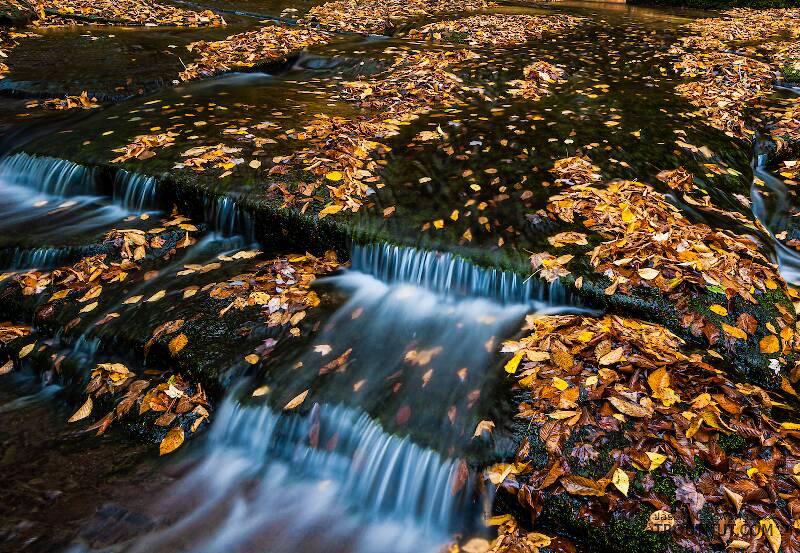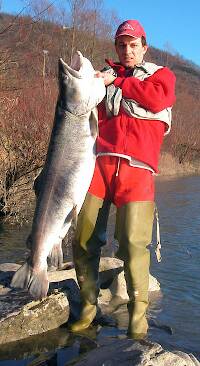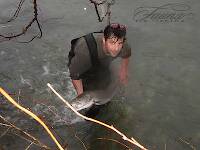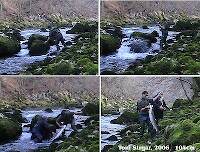
Salmonflies
Pteronarcys californica
The giant Salmonflies of the Western mountains are legendary for their proclivity to elicit consistent dry-fly action and ferocious strikes.
Featured on the forum

This specimen resembled several others of around the same size and perhaps the same species, which were pretty common in my February sample from the upper Yakima. Unfortunately, I misplaced the specimen before I could get it under a microscope for a definitive ID.

Troutnut is a project started in 2003 by salmonid ecologist Jason "Troutnut" Neuswanger to help anglers and
fly tyers unabashedly embrace the entomological side of the sport. Learn more about Troutnut or
support the project for an enhanced experience here.
Dreedee
Posts: 16
Posts: 16
Dreedee on Jul 31, 2008July 31st, 2008, 10:37 am EDT
An unnamed river, which I regularly fish, once teamed with trout 20" plus. In the past 8 years, those large fish have vanished. The DNR supervisor for this area of Wisconsin, says the trout are smaller, though more numerous, because the stream ecosystem has improved. He said, rightly, that a lot of the water was marginal. Now, there are more miles of trout water, and better mayfly and caddis hatches. But there are very, very few 20" inchers. The DNR guy's attitude is: "Just be glad that the river is improved. The small fish are a great benefit." I love a healthy river. But I miss those days to fishing it when I'd take a lot of browns in the 12-inch range, a few in the 14-16 inch range, and, on occasion the 20-incher. Do any of you knowledgeable anglers think I'm off base for being disappointed with the "improvements?" Yes, I know--there is a great irony at work here.
Trtklr on Jul 31, 2008July 31st, 2008, 11:09 am EDT
can you move downstream, I find the closer I get to the mouth the water becomes more marginal. I made the mistake of telling the guy at the orvis shop where I was fishing a local river(i was really new to trout fishing then)and he said wow I always thought it was pretty chubby down there. I haven't caught a decent size trout in that section since. so maybe other anglers will get deterred by the small trout and not fish it as much and eventually you'll get bigger trout in there again. kind of reminds me of the 60,000 trout guy, whats important to you when you fish?
I have seen nothing more beautiful than the sunrise on a cold stream.
RleeP on Jul 31, 2008July 31st, 2008, 11:34 am EDT
Without knowing the river you are referring to and without knowing the difference in the composition of the fishery then vs. now, its hard, IMO, to say which is "better" and which is not. For example, was the river in question previously a Class II water under WI's system and supplemented with fingerlings, fish that often attain some pretty good size and is it an all-wild Class I fishery now with a more natural balance between fish size and available forage, and hence now carries on average, smaller trout?
If so, I would consider it "better" now than then...
But that is a subjective view on my part because I prefer smaller wild fish to bigger stocked fish (even if they entered the stream as fingerlings as is often the case in WI).
But if this is what happened (and I'm only offering it as one of a number of possibilities), I don't think you're "off-base" in your disappointment. You have every right to your own subjective feelings about the matter. It is after all, what keeps both mustard AND mayonnaise manufacturers in business wherever ham sandwiches are popular...:)
People differ.
If so, I would consider it "better" now than then...
But that is a subjective view on my part because I prefer smaller wild fish to bigger stocked fish (even if they entered the stream as fingerlings as is often the case in WI).
But if this is what happened (and I'm only offering it as one of a number of possibilities), I don't think you're "off-base" in your disappointment. You have every right to your own subjective feelings about the matter. It is after all, what keeps both mustard AND mayonnaise manufacturers in business wherever ham sandwiches are popular...:)
People differ.
Dreedee
Posts: 16
Posts: 16
Dreedee on Jul 31, 2008July 31st, 2008, 2:50 pm EDT
It is a river that does stock fingerlings. And there has been much more natural reproduction. And it IS more of a dry fly river than it used to be. But, ah, there was a period when the hatches were good, as were the size of the fish. I guess I just miss that feeling of my heart pulsing in my throat when a trout the size of my thigh would swim into view.
Quick Reply
Related Discussions
Topic
Replies
Last Reply
Five days of warmwater flyfishing in southeastern Michigan - from Jonathon
In Fishing Reports by Jmd123
In Fishing Reports by Jmd123
0
Jul 22, 2009
by Jmd123
by Jmd123
0
Jan 27, 2017
by Mcflyangler
by Mcflyangler
Re: Identification of a possible Cordulegaster Dragonfly Nymph
In Cordulegaster Dragonfly Nymph by IanB
In Cordulegaster Dragonfly Nymph by IanB
6
Feb 10, 2017
by Taxon
by Taxon
2
Jul 2, 2009
by DayTripper
by DayTripper




